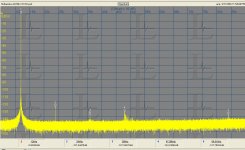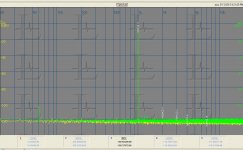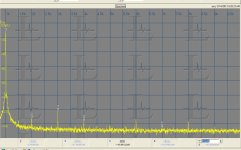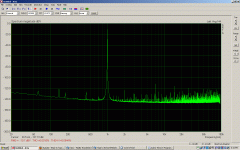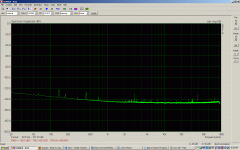The DAC quality will degrade rapidly if you go above 192K.
Not with a audio ADC. But the industrial ADCs sure can.
It would be nice to actually do THD20 from 20kHz. As it is we can barely do THD2.
The IM products from parasitc osc do move down but it would be nice to see a bit higher up.
Maybe I getting too old but I just don't like digital scopes.
I hear the noise floor on an EMU1212 is flat out to 100K
The 1212 has the AK5394.
Cheers,
The DAC quality will degrade rapidly if you go above 192K. There is 384K and 768K stuff but the noise floor and distortion go up radically. What are you looking for up there? The QA100 scope may be your best tool for looking at higher frequencies. I use a Tek 7L5 to look for aliases on DACs, it works well.
The Atmel in the Audio Widget can't process the throughput to get above 192K. Its a limitation of the endpoints. We are looking at a TI that may well be able to but that's some time in the future.
You could also use undersampling and other arcane tricks to get extended response but probably not worth it.
In looking at a usable 200khz, with at least a 10xFs window. That is, to show harmonics up to 10th for 20k, and more for lower frequencies. I find this very important, and yes I'm considering a digital scope or spectrum analyzer up to 1k (new) for this, but obviously a specialized USB interface would be cheaper and better at low freq like 100hz.
The only instrument that does this well is AP system2 and newer models, which are >2k$ used.
Amanero does 384k with the same Atmel processor (but the widget uses many more features... Can we drop the dac functions for instance?)
I'm not sure for Linux, but on windows drivers must be written anyway and 192k or 352k or whatever are as easy to program as 96k.
The hardest part is low noise in the hardware.
The reason why sound cards really suck above 96k is unknown to me.
AK5394a ADC performance
Here is a measurement of the AK5394a + Shibasoku AG16 at 12 KHz. The strongest residual is at -127 dB. I'm not sure I could duplicate this since everything needs to be working perfectly. The overall THD calculates to -125 dB or .00005%.
The AKD5394a was externally clocked with a really good 24.576 OXCO. I'm using Juli@ card into Praxis and it takes as much a 1/2 hour to make the measurement if the resolution is really high, necessary to see the close in jitter.
The AK5394a noise floor does not rise with frequency. The Juli@ card also uses the AK5385b. That chip does show a rise in noise floor.
I see a 100 KHz limit but no limits below 100 KHz for measurements.I personally think looking for -100 or even -80 dB harmonics at 100 KHz+ isn't meaningful. The 10 bit QA100 will show you everything you could possibly be interested in, and its easier, quicker to use and done. Creating these things looks like a quick and fun task. It is for the first few hours or days, but after 6 months of fiddling it gets real old. The Audio Widget has had several years of patient and determined development and tweaking by Borge, Alex and some others. Getting to that stage is a lot of work. I suggest building on it.
Borge asked me to send over my sketches for the components of this project which I will. Isolation and very good clocking are part of what I have sketched out so far. Getting the multiple power supplies necessary for this will be a bit of a challenge, especially if it can be powered from USB. I think USB power is important for getting really low noise, since the whole system can float running on batteries. I'll post them here as well. (Or should this be a new thread?
If you want to go all out create an analysis package on Linux that exploits what the capture system can do. Many of the pieces exist and are well debugged. A touch screen interface, a dedicated itx board/x86 processor and you could make magic.
Here is a measurement of the AK5394a + Shibasoku AG16 at 12 KHz. The strongest residual is at -127 dB. I'm not sure I could duplicate this since everything needs to be working perfectly. The overall THD calculates to -125 dB or .00005%.
The AKD5394a was externally clocked with a really good 24.576 OXCO. I'm using Juli@ card into Praxis and it takes as much a 1/2 hour to make the measurement if the resolution is really high, necessary to see the close in jitter.
The AK5394a noise floor does not rise with frequency. The Juli@ card also uses the AK5385b. That chip does show a rise in noise floor.
I see a 100 KHz limit but no limits below 100 KHz for measurements.I personally think looking for -100 or even -80 dB harmonics at 100 KHz+ isn't meaningful. The 10 bit QA100 will show you everything you could possibly be interested in, and its easier, quicker to use and done. Creating these things looks like a quick and fun task. It is for the first few hours or days, but after 6 months of fiddling it gets real old. The Audio Widget has had several years of patient and determined development and tweaking by Borge, Alex and some others. Getting to that stage is a lot of work. I suggest building on it.
Borge asked me to send over my sketches for the components of this project which I will. Isolation and very good clocking are part of what I have sketched out so far. Getting the multiple power supplies necessary for this will be a bit of a challenge, especially if it can be powered from USB. I think USB power is important for getting really low noise, since the whole system can float running on batteries. I'll post them here as well. (Or should this be a new thread?
If you want to go all out create an analysis package on Linux that exploits what the capture system can do. Many of the pieces exist and are well debugged. A touch screen interface, a dedicated itx board/x86 processor and you could make magic.
Attachments
Last edited:
I think adding an ultra low distortion oscillator and a matched notch filter would enhance the performance limits to the range of the Shibasoku. This could be the most difficult part.
I do not want an oscillator and/or notched filter as part of this project. Just a high performance ADC->USB device appears to be complex enough. The oscillator and notch filter are part of a different thread (and a different project).
I see a 100 KHz limit but no limits below 100 KHz for measurements.I personally think looking for -100 or even -80 dB harmonics at 100 KHz+ isn't meaningful. The 10 bit QA100 will show you everything you could possibly be interested in, and its easier, quicker to use and done.
I have to recheck your thread, but did you improve the HF noisefloor of the QA100? I remember it was raising quicker than the e-mu (from QA own measurements).
I do not want an oscillator and/or notched filter as part of this project. Just a high performance ADC->USB device appears to be complex enough. The oscillator and notch filter are part of a different thread (and a different project).
+1. Keep it simple and the best we can at its specialized function.
Here is a measurement of the AK5394a + Shibasoku AG16 at 12 KHz. The strongest residual is at -127 dB. I'm not sure I could duplicate this since everything needs to be working perfectly. The overall THD calculates to -125 dB or .00005%.
The AKD5394a was externally clocked with a really good 24.576 OXCO. I'm using Juli@ card into Praxis and it takes as much a 1/2 hour to make the measurement if the resolution is really high, necessary to see the close in jitter.
The AK5394a noise floor does not rise with frequency. The Juli@ card also uses the AK5385b. That chip does show a rise in noise floor.
I see a 100 KHz limit but no limits below 100 KHz for measurements.I personally think looking for -100 or even -80 dB harmonics at 100 KHz+ isn't meaningful. The 10 bit QA100 will show you everything you could possibly be interested in, and its easier, quicker to use and done. Creating these things looks like a quick and fun task. It is for the first few hours or days, but after 6 months of fiddling it gets real old. The Audio Widget has had several years of patient and determined development and tweaking by Borge, Alex and some others. Getting to that stage is a lot of work. I suggest building on it.
Borge asked me to send over my sketches for the components of this project which I will. Isolation and very good clocking are part of what I have sketched out so far. Getting the multiple power supplies necessary for this will be a bit of a challenge, especially if it can be powered from USB. I think USB power is important for getting really low noise, since the whole system can float running on batteries. I'll post them here as well. (Or should this be a new thread?
If you want to go all out create an analysis package on Linux that exploits what the capture system can do. Many of the pieces exist and are well debugged. A touch screen interface, a dedicated itx board/x86 processor and you could make magic.
Hi Demian,
Why would USB power be important for low noise. I would think complete galvanic isolation
between the ADC-analog board would be better all around with any external power source
batteries or otherwise.
Even with Dick's TT, two op amps I went through a lot of batteries in a short period of time.
I'm quite tired of spending the money on replacements. A rechargeable solution with bigger batteries would be better. It's a big one time expense which will save plenty over time.
I would do a +/- 24V system and regulate down from there. One can run a lot stuff of something like that.
The max sample speed is not important at this time since the 5394A doesn't go much above 192ksps.
Let's continue this in a new thread.
Cheers,
Hi Demian,
I started a new thread for further discussion of the ADC project.
http://www.diyaudio.com/forums/equipment-tools/231848-capturewidget.html#post3406284
Cheers,
I started a new thread for further discussion of the ADC project.
http://www.diyaudio.com/forums/equipment-tools/231848-capturewidget.html#post3406284
Cheers,
A quick update on my observations. First the EMU Tracker Pre and the )$)$ use the same ADC, AK5385a as does the ESI Juli@ and the RME HDSP9632. The analog implementations vary and the RME seems to have the best (most robust) interface to the host PC. It should given its market and application, but even that will get hammered if I start something line a VNC session moving screens remotely.
Attached is the RME loopback distortion and noise floor. This is going through the Praxis so the internal opamps in the Praxis are limiting the performance some. Its lower 2nd Harmonic that I get with the other devices on loopback. I'll connect the ShibaSoku later this week to get an idea of what can be expected.
I get much better results from the AKD5394A demo board.
Other notes (before I forget). The Tracker pre only runs at 44.1 and 48 on XP (at least with the drivers from EMU on their site). It runs up to 192 on Win 7. The 0404 does run up to 192 on XP. On Win 7 to get the input sensitivity down I need to set the gain in the windows mixer to 5 on the input. I still get occasional glitches at 192 with the EMU stuff.
I'll post a picture of the Tracker insides later this week.
Attached is the RME loopback distortion and noise floor. This is going through the Praxis so the internal opamps in the Praxis are limiting the performance some. Its lower 2nd Harmonic that I get with the other devices on loopback. I'll connect the ShibaSoku later this week to get an idea of what can be expected.
I get much better results from the AKD5394A demo board.
Other notes (before I forget). The Tracker pre only runs at 44.1 and 48 on XP (at least with the drivers from EMU on their site). It runs up to 192 on Win 7. The 0404 does run up to 192 on XP. On Win 7 to get the input sensitivity down I need to set the gain in the windows mixer to 5 on the input. I still get occasional glitches at 192 with the EMU stuff.
I'll post a picture of the Tracker insides later this week.
Attachments
A quick update on my observations. First the EMU Tracker Pre and the )$)$ use the same ADC, AK5385a as does the ESI Juli@ and the RME HDSP9632. The analog implementations vary and the RME seems to have the best (most robust) interface to the host PC. It should given its market and application, but even that will get hammered if I start something line a VNC session moving screens remotely.
Attached is the RME loopback distortion and noise floor. This is going through the Praxis so the internal opamps in the Praxis are limiting the performance some. Its lower 2nd Harmonic that I get with the other devices on loopback. I'll connect the ShibaSoku later this week to get an idea of what can be expected.
I get much better results from the AKD5394A demo board.
Other notes (before I forget). The Tracker pre only runs at 44.1 and 48 on XP (at least with the drivers from EMU on their site). It runs up to 192 on Win 7. The 0404 does run up to 192 on XP. On Win 7 to get the input sensitivity down I need to set the gain in the windows mixer to 5 on the input. I still get occasional glitches at 192 with the EMU stuff.
I'll post a picture of the Tracker insides later this week.
That's typically windows. Start up another application and anything heavy on resources slows everything down.
What is this 'the )$)$ use".
"I need to set the gain in the windows mixer to 5 on the input."
Is there any way to bypass this altogether? This really gets in the way.
When I use the EMU0204 I leave everything in windows cranked up all the way just to be sure. If this got changed and not noticed our measurements would be useless.
What is this 'the )$)$ use".
Sorry, Typo, its EMU 0404.
I found the gain issue on Win 7 calibrating the Tracker to Praxis. Its a specific process and really removes a lot of errors. I was getting a really limited dynamic range and then I discovered in loopback I had to reduce the gain setting regardless of the analog settings.
Ultimately these music interfaces need a lot of tweaking/modification to work for measurement.
The RME is better suited. In its +4 mode its 3V out and in, which would work much better for audio. However its too expensive and has a lot of stuff that's not necessary for the task. The same for the Juli@ card. However they are desktop cards and less flexible in use.
With the devices on hand (my Juli is apart right now) this EMU 0404 is the best result. The RME did not do as well. Not sure why yet. This is 16 dB below FS. The analog in needs to be set for clipping at 3V to get this result. I think a lot has to do with the limited supply voltages in the EMU boxes. The RME has other things going on with analog gain switching etc. I'm not sure where performance gets lost in it. The absolute scale is not correct so ignore it.
Attachments
I think the esternal psu helps the emu.
I don't think so, unfortunately. The usb 0404 gets 5V externally. But then, it uses a number of DC-DC converters to provide various other voltages (including negative potential). I found those to be sources of noise.
E-MU 0404 USB mod wiki - diyAudio
tell me again... why are we reinventing this ADC tester thing? Instead of enlisting QA400 modifications from QuantAsylum guys (or others)? Are they willing to help get us what we want, the way we want it? -RNM
First of all Rick we are not the target market for the QA400. It's targeted to the Chinese manufactures. Not much money in DIY electronic hobbyist. I don't think they will do much more with the QA400 but there maybe something else in the works down the road.
We'll have to wait and see. The QA400 is closed. It's proprietary technology. Have you had much luck using it with any other software?
Secondly and more importantly this is our project by us and for us. I will get a lot more satisfaction from doing this than from any product I might buy. It's interesting, gratifying and educational.
I've got the EMU1212 up and running but I've got to say I'm pretty disappointed.
I think this is a waist of a AK5394A. Just my opinion though. It took me over half an hour to get ARTA calibrated with this thing. It won't work with out the application that goes with it and that really get's in the way of third party apps.
See for yourself. This is no good for high resolution measurement and is another reason we are doing the Capture Widget project.
The first pic is self explanatory and the second is with a 75 ohm load on the input.
I think this is a waist of a AK5394A. Just my opinion though. It took me over half an hour to get ARTA calibrated with this thing. It won't work with out the application that goes with it and that really get's in the way of third party apps.
See for yourself. This is no good for high resolution measurement and is another reason we are doing the Capture Widget project.
The first pic is self explanatory and the second is with a 75 ohm load on the input.
Attachments
- Status
- This old topic is closed. If you want to reopen this topic, contact a moderator using the "Report Post" button.
- Home
- Design & Build
- Equipment & Tools
- EMU0204 mods for FFT measurements
